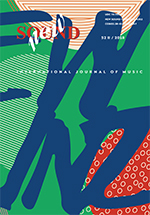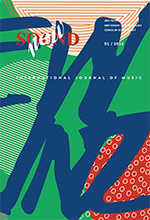Issue No. 44
In Memoriam
Mirjana Veselinović-Hofman – GORAN KAPETANOVIĆ (1969–2014)
Download: ser / eng
A Word of the Editor
Mirjana Veselinović-Hofman – EDITOR'S NOTE
Download: ser / eng
Composer Speaks
Vesna Mikić – A LOOK AT THE MIRROR/SCREEN. POP-UP INTERVIEW WITH SRĐAN HOFMAN
Download: ser / eng
Core Issue – Music 'Around' First World War and Stevan St. Mokranjac
Dario Martinelli – INTRODUCTION. GUEST-EDITOR'S NOTE
Download: ser / eng
Joan Grimalt – SOME MILITARY MUSICAL TOPICS BEFORE 1914
Abstract: The article deals with military musical topics in concert music. Historically, the First World War marks a shift in the value of those topics. In Romantic music, martial topics are mostly euphoric: the virtual marching characters are the "good guys". In most of the music after bloody conflict, however, the march represents the dark side of humanity's aggressiveness. This shift can be heard in Shostakovich's and Prokofiev's works, and has a clear precedent in the music of Gustav Mahler, who intuitively foresaw the forthcoming disasters. The article also describes two military topics that have received too little attention, despite their frequent use: the 'Dysphoric March' and the 'Toy Army'. (The latter was described, but not labelled, by Raymond Monelle [2000]).
Keywords: military musical topics, music before 1914, Raymond Monelle.
Download: ser / eng
Ricardo Nogueira de Castro Monteiro – THE FIRST WORLD WAR AND THE ASCENSION OF THE PHONOGRAPHIC INDUSTRY IN THE NEW WORLD
Abstract: The First World War years witnessed a radical and important change in the history of both music and phonographic industry, gradually putting popular rather than classical music under the spotlight and moving the axis of entertainment music production across the Atlantic into the New World. It is no coincidence that the first jazz, the first samba and also the first tango-canción were all recorded and released in the same year, 1917 - in the twilight of the Great War. This article intends to shed light on this process, discussing the cultural and socioeconomic factors that determined it.
Keywords: musicology, semiotics, tango, jazz, samba. music history, First World War, comparative history.
Download: ser / eng
Rima Povilioniene – REFERENCES TO LITHUANIAN MUSICAL LIFE IN LITHUANIAN PERIODICALS, 1914-1915: A REVIEW OF THE LITHUANIAN NEWS DAILY
Abstract: During the initial wartime years, the music life in Lithuania was slowed down first of all by the prevailing mood. On the other hand, Lithuanian evenings that were held at that time (their programmes usually consisted of one or two plays/performances and a musical part - a choir concert) acquired the role of fostering and promoting nationalism. The Lithuanian press often carried items about local choirs in various parts of the country (most often formed and led by the local organist). Systemised information in the years 1914 and 1915 is presented in the article: how musical life in Lithuania was covered in one of the main Lithuanian newspapers published in Vilnius – Lithuanian News.
Keywords: musical events in Lithuania in 1914–1915, Lithuanian press, dailies Lithuanian News (Lituvos žinios), Hope (Viltis), Dawn (Aušra).
Download: ser / eng
Paolo Ribaldini – A CONCEPTUAL CONNECTION BETWEEN CLASSIC HEAVY METAL AND WORLD WAR I: THE CASE OF IRON MAIDEN'S 'PASCHENDALE' AND MOTÖRHEAD'S '1916'
Abstract: In this essay, I deal with the connections between World War I and the musical style of early Heavy Metal (HM). HM has always dealt thoroughly with the topic of war, sometimes criticizing it, sometimes celebrating it. World War II is very frequent, lyrical topic, World War I is definitely less addressed, for a number of reasons. I, nevertheless argue that, in spite of this general lack of interest, with such a historical topic early HM shares the ideological perspective of a crisis in the existing systems of values.
Keywords: classic or early heavy metal, World War I, Iron Maiden, Mötorhead.
Download: ser / eng
Jeffrey Wood – THE GREAT WAR AND THE CHALLENGE OF MEMORY
Abstract: An assessment of the responses of "classical" composers to World War I. A discussion of the responsibilities of the composer as they respond to war will be followed by a presentation of four different "modes" of artistic response: "heroic," "elegiac," "denunciation," and "reconciliation." These responses represent different modes of expression by which composers are able to respond to events such as World War I. Specific works representing these responses – Arthur Bliss' Morning Heroes, Alban Berg's Wozzek, Edward Elgar's Violoncello Concerto, John Foulds' A World Requiem and Benjamin Britten's War Requiem – will also be discussed.
Keywords: World War I, rememberance, Memoralisation in music, Paul Fussell.
Download: ser / eng
Stefan Schmidl – MUSIC OF THE GREAT WAR. OBSERVATIONS ON A NEGLECTED REPERTOIRE
Abstract: Little is generally known today about the music of the First World War. On the assumption that music has to be considered as extraordinary among all the media 'distributing' it (i.e. shaping its perception in various ways), my paper concerns three categories of music written under the influence of the Great War and in response to it: with music representing sovereigns and nations (based on the example of the musical glorification of the Habsburgs in WWI), in relation to the vanguard style and its employment as a signifier of the war and finally, the great war's ambiguous legacy in music.
Keywords: First World War, Music History, Representation studies, Historical aestheticisation.
Download: ser / eng
Ivana Perković – THE WRITTEN-ORAL PARADIGM IN THE TRANSCRIPTIONS OF CHURCH MUSIC BY STEVAN STOJANOVIĆ MOKRANJAC
Abstract: The question of the relation between the written and oral media of communication finds its application not only in linguistics, but also in philosophy, sociology, ethnology and other areas. Other possibilities for applying this theory in musicology were noted some fifty years ago, but when it comes to church music, such issues have not yet been subject to wider examination. This text considers the musicological implications of orality, literacy and "second literacy" in the collection of Serbian church chant transcribed and published by Stevan Stojanović Mokranjac. Psychodynamic elements of the oral-written/literal paradigm, with a special emphasis on the latter, are analysed, with the aim of defining a different context for the understanding of Mokranjac's specific approach to chanting tradition.
Keywords: Stevan Stojanović Mokranjac, Serbian chant, oral-written paradigm, Walter Onq, musical cognition, musical memorisation, Octoechos, formulae, musicology.
Download: ser / eng
Roksanda Pejović – AN ATTEMPT TO EVALUATE SERBIAN MUSIC BETWEEN THE WORLD WARS (1919-1941)
Abstract: When evaluating Serbian music between the two world wars, we take as our starting point compositions that are valuable in their own right, weather their creators were oriented towards tradition and moderate stylistic trends, or were adherents of the latest tendencies in music. Only compositions that defined their creators' stylistic profiles are considered. We are aware that the value judgments pronounced by older generations of musicologists may differ from the attitude that their younger colleagues have towards the past changes to a degree, so that certain compositions once well received fade over time, but the most powerful and original ones lose nothing of their impact. We draw attention to Romantic foundations and inspiration that renowned European composers found in folk music in order that we may confirm the existence of the same phenomena in the music life of Belgrade. We also observe how Serbian composers mastered novel tendencies and how these tendencies endured, nothing that they generally trailed behind analogous phenomena in literature and the fine arts.
Keywords: national stylistic orientation, romantic-impressionist style, European musical standard, extreme musical tendencies, evaluation of musical creative work based on the selection of most important works.
Download: ser / eng
Andrija Filipović – HUMAN, ALL TO HUMAN: BARE REPETITIONS AND ORGANISM IN MINIMAL MUSIC
Abstract: The main thesis in this work is that minimalism procedures neutral sensory perception and is thereby complicit not only in the production of the body qua organism, but also in the wider socio-politico-economic environment that such a conception of the body entails. Minimalism produces neutral sensory perception by insisting on "bare repetition", the literal, direct, and immediate materiality of work of art; in other words, it insists on a specific ontological relation between difference and the same, whereby the same, singular, and identical, predicated on representational thought, replace the different, which is expressed in becoming. Minimalism, neutral perception, the relative immanence of capitalism, and the body qua organism constitute a sort of chain, which should be subjected to critical analysis and critique based on the concepts of difference, event, and encounter.
Keywords: minimalism, repetition, organism, ontology, the body sensory perception.
Download: ser / eng
New Works
Ira Prodanov Krajišnik, Nataša Crnjanski – BEYOND ZERO: 1914-1918 – A CENTERY AFTER
Abstract: To mark a centennial of WWI, Aleksandra Vrebalov wrote a new string quartet Beyond Zero: 1914-1918 which accompanied a film by Bill Morrison. The paper presents the means with which the musical structure was created to resonate with the subject, especially the technique of using quotations (musical and non-musical) in order to make music more "pictorial". The film, made from archive material preserved from WWI, with all its elements of devastation, uses moving pictures to the accompaniment of the "sounding pictures" of music.
Keywords: Aleksandra Vrebalov, quotation, Great War, WWI, text, zero, Dadaism, Bartok, Owen, Huelsenbeck, Gerard, film.
Download: ser / eng
Students' Papers
Miloš Bralović – THE COLLAGE-SHAPED WORLDS OF GUSTAV MAHLER'S RÜCKERT SYMPHONIES
Abstract: The main goal of this paper was to reveal the very beginnings of collage technique in Western art. Musical materials taking place in the scherzo movements of Gustav Mahler's Fifth, Sixth and Seventh Symphony are arranged astonishingly similar to arrangement of different materials (i.e. fabric, wallpaper, newspaper fragments etc.) in first collage paintings by Picasso and Braque. Considering the fact that composing of the symphonies occurred significantly earlier than the first collage paintings, we come to a conclusion that collage technique pioneered not in the art of painting but in that of music.
Keywords: collage, Gustav Mahler, Rückert symphonies, scherzos, Pablo Picasso, Georges Braque.
Download: ser / eng
Festivals and Symposia
Marina Marković – The 22nd Obzorja na Tisi – Dani Josifa Marinkovića [The Tisa Horisons: Days of Josif Marinković]
Download: ser / eng
Reviews
Jelena Janković Beguš – Dragana Stojanović Novičić, PhD (2013). Vinko Globokar: muzička odiseja jednog emigranta [Vinko Globokar: The Musical Odyssey of an Emigré]. Belgrade: Faculty of Music, Department of Musicology. Studies in Musicology – Monographs – Vol. 18
Download: ser / eng
Radoš Mitrović – Dragana Jeremić-Molnar, Aleksandar Molnar: Adorno's Schubert. A Path towards the Theory of Mimesis. Belgrade: Faculty of Music, 2014. Monographic Series. Tempus Project InMusWB, IV, book 1. ISBN 978-86-88619-44-8. 191 pages
Download: ser / eng
Radoš Mitrović – Dragana Jeremić-Molnar, The Winter Journey of Wilhelm Müller and Franz Schubert. Belgrade: Faculty of Music, 2014. Monographic Seies. Tempus Project InMusWB, IV, book 2. ISBN 978-86-88619-44-8. 196 pages
Download: ser / eng
Marija Masnikosa – Ivana Petković, Olga Otašević, Stevan Stojanović Mokranjac u napisima "drugih" [Stevan Stojanović Mokranjac in the Writings of "Others"]
Download: ser / eng
Ivana Neimarević – Marko Nikodijević: dark/rooms. col legno, 2013
Download: ser / eng


